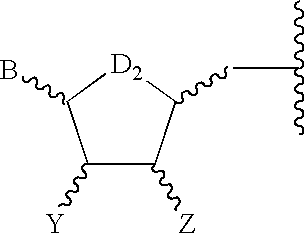Composition and method for inhibiting platelet aggregation
a technology of mono and dinucleotide polyphosphates, which is applied in the direction of peptide/protein ingredients, extracellular fluid disorder, immune disorders, etc., can solve the problems of blockade of other vessels, pulmonary arteries, serious diseases,
- Summary
- Abstract
- Description
- Claims
- Application Information
AI Technical Summary
Benefits of technology
Problems solved by technology
Method used
Image
Examples
example 1
2′(3′)-O-((phenylaminocarbonyl)-uridine 5′-)triphosphate
[0260]Uridine 5″-triphosphate, ditributylammonium salt (100 mg, 0.176 mmol; prepared from the trisodium salt by treatment with Dowex 50W×4 H+ in water, followed by mixing the protonated species with an excess of tributylamine, stripping and lyophilization) was dissolved in dry DMF (1 mL) and phenylisocyanate (19 uL, 0.176 mmol) added. The reaction mixture was heated at 45° C. for 15 minutes, at which point a further portion of phenylisocyanate (19 uL, 0.176 mmol) was added. The solution was heated at 45° C. overnight and the DMF was removed on a rotary evaporator. The residual oil was partitioned between water (2 mL) and ethyl acetate (2 mL) and the layers were separated. The aqueous layer was extracted twice more with ethyl acetate (2 mL each) and the water was removed on a rotary evaporator. The residue was dissolved in water (1.5 mL) and the product isolated by repeated injections onto a preparative HPLC column (Alltech Nucl...
example 2
2′(3′)-O-(phenylaminocarbonyl)-P1,P4-Di(uridine 5′-)tetraphosphate and P1,P4-Di-(2′(3′)-O-(phenylaminocarbonyl)uridine 5′-)tetraphosphate
[0262]P1,P4-Di(uridine 5′-) tetraphosphate, ditributylammonium salt (211 mg, 0.182 mmol; prepared from the tetrasodium salt by treatment with Dowex 50W×4 H+ in water, followed by mixing the protonated species with an excess of tributylamine, stripping and lyophilization) was dissolved in dry DMF (2 mL) and phenylisocyanate (40 uL, 3.64 mmol) added in a single portion. The homogeneous reaction mixture was heated overnight at 45° C., whereupon TLC (silica gel, 50% isopropanol / 50% ammonium hydroxide) indicated a substantial conversion to two products. The solvent was removed on a rotary evaporator and the residue was partitioned between water (7 mL) and ethyl acetate (10 mL). The layers were separated, and the aqueous was extracted twice more with ethyl acetate. (10 mL each). The water was removed from the aqueous extract and the residual oil lyophili...
example 3
2′,3′-(benzyl)methylenedioxy-P1,P4-Di(uridine 5′-)tetraphosphate and P1,P4-Di-(2′,3′-((benzyl)methylenedioxy) uridine 5′-)tetraphosphate
[0266]P1,P4-Di(uridine 5′-)tetraphosphate, tetrasodium salt (290 mg, 0.332 mmol) was dissolved in 98% formic acid and phenylacetaldehyde, dimethyl acetal (110 uL, 0.662 mmol) added. The reaction was stirred at ambient temperature for 3 days, at which point TLC (silica gel, 50% isopropanol / 50% ammonium hydroxide) and HPLC (C18) showed good conversion to two less polar products. The formic acid was removed on a rotary evaporator, and the residue partitioned between 0.7 M ammonium bicarbonate (15 mL) and butyl acetate (15 mL). The layers were separated and the aqueous was washed with a further portion of butyl acetate (10 mL). The aqueous layer was stripped and the residue lyophilized overnight. The crude product was dissolved in water (5 mL) and the components separated by preparative HPLC (Waters Novapak C18, 6 um, 25 X 100 mm, gradient from 0.1 M am...
PUM
| Property | Measurement | Unit |
|---|---|---|
| size | aaaaa | aaaaa |
| size | aaaaa | aaaaa |
| temperature | aaaaa | aaaaa |
Abstract
Description
Claims
Application Information
 Login to View More
Login to View More - R&D
- Intellectual Property
- Life Sciences
- Materials
- Tech Scout
- Unparalleled Data Quality
- Higher Quality Content
- 60% Fewer Hallucinations
Browse by: Latest US Patents, China's latest patents, Technical Efficacy Thesaurus, Application Domain, Technology Topic, Popular Technical Reports.
© 2025 PatSnap. All rights reserved.Legal|Privacy policy|Modern Slavery Act Transparency Statement|Sitemap|About US| Contact US: help@patsnap.com



